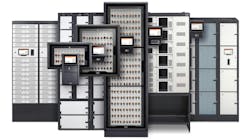AI Deployments are Reshaping Intra-Data Center Fiber and Communications
Artificial Intelligence is fundamentally changing the way data centers are architected, with a particular focus on the demands placed on internal fiber and communications infrastructure. While much attention is paid to the fiber connections between data centers or to end-users, the real transformation is happening inside the data center itself, where AI workloads are driving unprecedented requirements for bandwidth, low latency, and scalable networking.
Network Segmentation and Specialization
Inside the modern AI data center, the once-uniform network is giving way to a carefully divided architecture that reflects the growing divergence between conventional cloud services and the voracious needs of AI. Where a single, all-purpose network once sufficed, operators now deploy two distinct fabrics, each engineered for its own unique mission.
The front-end network remains the familiar backbone for external user interactions and traditional cloud applications. Here, Ethernet still reigns, with server-to-leaf links running at 25 to 50 gigabits per second and spine connections scaling to 100 Gbps. Traffic is primarily north-south, moving data between users and the servers that power web services, storage, and enterprise applications. This is the network most people still imagine when they think of a data center: robust, versatile, and built for the demands of the internet age.
But behind this familiar façade, a new, far more specialized network has emerged, dedicated entirely to the demands of GPU-driven AI workloads. In this backend, the rules are rewritten. Port speeds soar to 400 or even 800 gigabits per second per GPU, and latency is measured in sub-microseconds. The traffic pattern shifts decisively east-west, as servers and GPUs communicate in parallel, exchanging vast datasets at blistering speeds to train and run sophisticated AI models. The design of this network is anything but conventional: fat-tree or hypercube topologies ensure that no single link becomes a bottleneck, allowing thousands of GPUs to work in lockstep without delay.
This separation is more than a technical nicety; it is a direct response to the so-called "slowest sheep" problem. When even a single GPU cluster is forced to wait for data, the entire training process can grind to a halt, wasting valuable compute time and inflating operational costs. By dedicating a high-speed, low-latency network to AI workloads, data centers can keep GPUs running at peak efficiency, often above 95% utilization. Industry estimates suggest that every percentage point reduction in GPU idle time can translate to hundreds of thousands of dollars in annual savings for a large cluster.1
The shift is not without its challenges. The backend network’s insatiable appetite for bandwidth has all but eliminated copper from the equation, making single-mode fiber the standard bearer for intra-data center communications. Optical transceivers capable of 800 gigabits per second come with a steep energy cost, requiring advanced cooling solutions to keep power consumption in check. And while this physical separation brings clear performance benefits, it also limits the flexibility to share resources between workloads, demanding careful planning and foresight from data center architects.
In essence, the AI data center now operates as a dual-purpose facility: one part traditional cloud, one part supercomputer. The implications for fiber and communications infrastructure are profound, as operators strive to balance the demands of two radically different worlds within a single building.
Exponential Bandwidth, Low Latency, and Surging Cabling Demands
The relentless push of artificial intelligence into every corner of the data center has rewritten the rules for network performance and physical infrastructure. Where traditional applications could tolerate modest bandwidth and the occasional delay, today’s AI workloads, especially those powering real-time inference and decision-making, demand nothing less than instantaneous data movement between processors, GPUs, and storage. The internal network is now expected to keep pace with computational throughput that would have been unimaginable just a few years ago.
At the heart of this transformation is a dual mandate: ultra-high bandwidth and ultra-low latency. AI workloads, with their voracious appetite for data, can easily overwhelm legacy copper-based networks. Fiber optics, with their ability to carry vast amounts of information at the speed of light, have become the undisputed backbone of intra-data center communications. Only fiber can reliably shuttle the massive datasets required for AI training and inference without introducing bottlenecks that would cripple performance.
But the shift to fiber is about more than just raw speed. Real-time AI applications require near-instantaneous data transmission, leaving no room for delays that could disrupt critical decision-making. Fiber’s inherent advantages (low signal loss, immunity to electromagnetic interference, and the ability to transmit data at the speed of light) make it the only viable solution for meeting these stringent latency requirements.
The impact on data center cabling is profound. A single AI server equipped with eight GPUs, for example, may require eight dedicated backend ports plus two front-end ports—a far cry from the one or two ports typical of traditional servers. This explosion in connectivity needs translates directly into a surge in fiber density. Industry studies suggest that AI-focused data centers may require two to four times more fiber cabling than their hyperscale counterparts, a figure that underscores the scale of the challenge.
Meeting these demands has forced a wave of innovation in cabling technology. Solutions like MPO-16 connectors and rollable ribbon cables have emerged to reduce cable diameter by as much as 50%, enabling higher port density in patch panels and easing the strain on physical infrastructure. Meanwhile, prefabricated, modular cabling systems are cutting deployment times from years to months, as demonstrated in ambitious projects like the Memphis X AI data center.
As AI continues to drive the evolution of data center infrastructure, the need for exponential bandwidth, minimal latency, and ever-greater fiber density will only intensify. The industry’s response, ranging from advanced cabling solutions to modular deployment strategies, reflects a recognition that the future of AI is being built literally one fiber at a time.
Architectural Shifts
The relentless demands of artificial intelligence are reshaping data center architecture from the ground up, driving innovations that challenge traditional design paradigms. As AI workloads push the limits of computational intensity and network speed, data centers are undergoing a transformation that touches everything from the physical layout of servers to the way power and cooling are managed.
One of the most significant shifts is the adoption of rail-optimized fabric designs, such as NVIDIA’s Clos architecture. This approach is engineered specifically for GPU-centric environments, ensuring that every GPU is connected to a leaf switch with the minimum number of network hops. The result is a streamlined, high-performance network that is critical for distributed training workloads, where even minor delays can cascade into significant inefficiencies. By minimizing latency and maximizing bandwidth between GPUs, these rail-optimized stripes enable AI models to train faster and more efficiently than ever before.
But the architectural revolution doesn’t stop at networking. The power and cooling requirements of AI have exploded, with modern AI cabinets now consuming between 48 and 120 kilowatts, far beyond the 6 to 10 kilowatts typical of traditional server racks. This surge in energy consumption has forced data center operators to rethink their approach to infrastructure. Liquid cooling systems, once a niche technology, are now becoming mainstream, offering a more efficient way to dissipate the immense heat generated by densely packed GPUs. At the same time, co-packaged optics are being integrated into hardware to reduce energy waste and further streamline data movement within the rack.
Together, these architectural shifts represent a fundamental reimagining of the data center. By optimizing for the unique demands of AI, operators are building facilities that are not only faster and more powerful, but also more efficient and resilient, setting the stage for the next generation of artificial intelligence.
Scalability and Interconnectivity
As AI models grow in size and complexity, data centers must scale their internal networks to keep up, forcing a fundamental rethinking of how data centers are built and managed. As AI systems become larger and more complex, the internal networks that support them must not only expand in scale but also evolve in sophistication. This means not only increasing the number of fiber connections but also improving the way servers and storage systems are interconnected. Simply adding more fiber connections is no longer enough; the very architecture of connectivity must adapt to ensure seamless communication between thousands of servers and storage systems.
At the forefront of this evolution are scalable network fabrics. Modern data centers are increasingly turning to network virtualization and software-defined networking to orchestrate compute, storage, and networking resources with unprecedented flexibility. These technologies enable operators to dynamically allocate bandwidth, reroute traffic, and optimize performance in real time, ensuring that AI workloads, no matter how demanding, can be supported without costly overhauls of physical infrastructure. The result is a network that can grow and adapt alongside the AI models it serves, future-proofing investments and minimizing downtime.
Interconnectivity is equally critical. AI ecosystems thrive on dense, low-latency connections between servers and storage, enabling the rapid exchange of data that fuels training and inference. Emerging technologies like co-packaged optics are pushing the boundaries of what’s possible, embedding optical connections directly into processors and networking hardware. This integration brings light-speed communication closer to the heart of computation, slashing latency and dramatically increasing bandwidth within the data center.
Reliability and Resilience
The internal fiber network must be resilient, with minimal points of failure and high resistance to interference. In the world of artificial intelligence, downtime can be catastrophic to your bottom line. AI applications, from real-time analytics to autonomous decision-making, demand constant uptime and unwavering reliability. Behind the scenes, the internal fiber network must be engineered for resilience, with minimal points of failure and robust defenses against interference that could disrupt critical operations.
For this reason, fiber networks within the data center are designed with redundancy in mind. Modern data centers deploy fiber networks with multiple pathways and backup connections, ensuring that if one link fails, traffic can be instantly rerouted to maintain seamless operation. This fault-tolerant design is essential for protecting AI workloads, where even a brief interruption can cascade into costly delays or errors. By eliminating single points of failure, operators can guarantee that their networks remain operational under virtually any circumstance.
But redundancy is only part of the story. The industry is increasingly turning to AI itself to safeguard its infrastructure. Advanced monitoring systems now use machine learning algorithms to analyze network performance in real time, detecting subtle anomalies that might indicate impending problems. This predictive maintenance approach allows data center teams to address potential issues before they escalate into outages, further enhancing the reliability of the fiber network.
Together, these strategies create a data center environment where AI can thrive—one where the network is not just fast and scalable, but also resilient and self-healing. As AI continues to push the boundaries of what’s possible, the importance of reliability and resilience will only grow, ensuring that the infrastructure can keep pace with the demands of even the most advanced applications.
Future-Proofing Strategies
The relentless march of artificial intelligence is accelerating innovation within the data center, particularly in the realm of intra-data center networking. As AI models grow larger and more complex, the pressure mounts on operators to not only keep pace with current demands but also anticipate the needs of tomorrow. The result is a wave of new technologies and strategies designed to future-proof the modern data center, transforming it from a general-purpose facility into a hyperscale AI factory where every millisecond and terabit counts.
Key innovations include:
Copackaged Optics: By embedding optical links directly into processors and networking hardware, copackaged optics slash latency and power consumption while dramatically boosting bandwidth. This integration is critical for supporting the next generation of AI workloads, where speed and efficiency are paramount.
Network Virtualization: Virtualized network services allow for the dynamic allocation of resources, enabling operators to optimize performance for specific AI applications without the need for costly and time-consuming physical reconfiguration. This flexibility ensures that the network can adapt as workloads evolve.
AI-Driven Network Management: Artificial intelligence is now being used to manage and optimize the internal fiber network itself. Machine learning algorithms monitor performance in real time, predict potential issues, and forecast capacity needs, therebyreducing downtime and ensuring that the network remains robust as demand grows.
MPO-16 and VSFF Connectors: These advanced connectors are engineered to support not only today’s 800G speeds but also the 1.6T networks of the future, eliminating the need for disruptive re-cabling as bandwidth requirements escalate.
Active Optical Cables (AOCs): AOCs reduce reliance on traditional transceivers, offering a compact and efficient alternative for high-speed connections. While less flexible than structured cabling, they are increasingly favored for their simplicity and performance in dense, high-bandwidth environments.
These changes reflect the AI-driven paradigm shift in data center design. No longer are facilities built for general-purpose computing; they are evolving into hyperscale AI factories where network performance directly dictates the return on investment for multimillion-dollar GPU clusters. As the industry continues to innovate, the data center of the future will be defined by its ability to adapt, optimize, and scale—ensuring that it remains at the heart of the AI revolution.
Predictions in Data Center Communications Heading into 2030
As artificial intelligence continues to reshape the digital landscape, the data center communications industry stands on the cusp of transformative change. Over the next few years, several key trends are expected to emerge, each promising to further accelerate the capabilities and efficiency of AI-driven infrastructure.
1. Photonics and co-packaged optics will move from the cutting edge to the mainstream, revolutionizing how data moves within the data center. By integrating optical components directly into processors and networking hardware, these technologies will enable terabit-scale links and dramatically reduce the power required for each bit transferred—a critical advantage as energy costs and sustainability concerns grow.
2. AI-driven network automation will become the backbone of data center operations. Advanced machine learning algorithms will take on real-time traffic engineering, congestion avoidance, and predictive maintenance, minimizing downtime and reducing the need for manual intervention. This shift will not only boost reliability but also free up human operators to focus on higher-level strategic tasks.
3. The rise of edge data centers will demand new architectures for secure, low-latency, high-bandwidth communication between core and edge sites. As AI applications increasingly require real-time processing at the source of data, the network must evolve to support seamless coordination between distributed facilities without sacrificing speed or security.
4. Interoperability standards will accelerate, making it easier to deploy multi-vendor, multi-protocol networks that can flexibly adapt to the evolving demands of AI hardware and workloads. This standardization will lower barriers to innovation, allowing data center operators to mix and match best-in-class solutions from a diverse ecosystem of providers.
5. Optical circuit switching and advanced network fabrics such as Clos and mesh topologies will be widely adopted to support the massive east-west traffic generated by AI clusters. These architectures will further reduce latency and improve scalability, ensuring that the data center can keep pace with the explosive growth of AI.
These innovations will enable data centers to keep pace with the relentless growth of AI, ensuring that network communications remain a strategic enabler for the next generation of digital infrastructure.
AI infrastructure is transforming the requirements for fiber and communications within the data center. The shift to dense, high-bandwidth, low-latency fiber networks is essential for supporting the demands of AI workloads. As AI continues to evolve, data centers must adopt scalable, resilient, and intelligent network architectures to remain competitive and reliable.
Resources:
1. https://lumenalta.com/insights/6-steps-for-building-an-ai-data-center
About the Author

Melissa Reali
Melissa Reali is an award-winning data center industry leader who has spent 20 years marketing digital technologies and is a self-professed data center nerd. As Editor at Large for Data Center Frontier, Melissa will be contributing monthly articles to DCF. She holds degrees in Marketing, Economics, and Psychology from the University of Central Florida, and currently serves as Marketing Director for TECfusions, a global data center operator serving AI and HPC tenants with innovative and sustainable solutions. Prior to this, Melissa held senior industry marketing roles with DC BLOX, Kohler, and ABB, and has written about data centers for Mission Critical Magazine and other industry publications.





